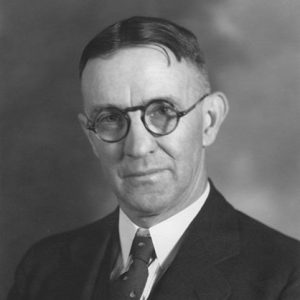Victor E. Shelford helped to create ecology as a distinct field. His work primarily focused on animal ecology and how plants and animals adapted and evolved in different environments together. He has been called the “father of animal ecology.”

Before he came to the University of Illinois…
Victor E. Shelford was born in Chemung, New York on September 22, 1877. He was the eldest son of Alexander Hamilton Shelford and Sarah Ellen Rumsey Shelford. He grew up in a farm family.
After 10 years of primary schooling, he taught in public schools in Chemung County from 1895 to 1897. Later, he started his undergraduate education at the University of West Virginia. According to the oral interview from March 24th, 1965, he recalled that he chose the University of Virginia because his uncle lived there. At the University of West Virginia, he met a professor named William E. Rumsey who was a zoologist and biologist. With this interaction, his interest in zoology and ecology started to grow.
True or False Question:
Victor E. Shelford finished his undergraduate degree at University of Illinois at Urbana Champaign majoring in ecology.
AnswerFalse, keep reading below to find out where he completed his degree.
Jerome H. Raymond, president of the University of West Virginia, moved to the University of Chicago and encouraged Shelford to also move. Raymond helped Shelford receive a scholarship. Shelford then earned his undergraduate, masters, and doctorate degrees at the University of Chicago. From 1903 to 1914, he taught zoology there.
In 1913, he published his first book called Animal Communities in Temperate America. Stephen A. Forbes, who contributed images to Shelford’s book, eagerly brought Shelford to the University of Illinois to the developing zoology department.

His career at the University of Illinois
For his first job, he worked as an assistant and associative zoology professor. Although he mainly taught zoology, his interests in ecology from his doctoral years continued. Forbes and Shelford helped to establish the field of ecology as a distinct field. While Forbes is known as the father of ecology, Shelford is well known for helping to lead the direction of study for this new field.
His work included creating classifications for animals, understanding how animals adapt to and survive in their environments, and what tools are needed in the lab of an animal ecologist. Every other summer he would conduct research at Puget Sound Laboratory. Here he used photoelectric cells, developed by fellow Illinois professor, Jakob Kunz, to measure light penetration in sea water.
In 1915, Shelford created an organization with biologists, professors and ecologists. What was the organization called?
A) Ecological Society of America
B) Biological Society of America
C) Scientists and Ecologists in Midwest
AnswerA) Ecological Society of America
In 1915, Shelford successfully organized the Ecological Society of America with biologists and professors, mainly from Midwest universities. He actively participated on the organizing committee. In 1916, he became the first president of the Society.
As his interests and enthusiasm toward ecology increased, he looked for effective methods to learn and conduct experiments with students. From 1914 to 1929, he was in charge of the research labs in the Illinois Natural History Survey. Moreover, in 1929, he published a book called Laboratory and Field Ecology. In the book, he emphasizes appropriate experimental study for an effective ecology course.
From his knowledge of ecology, he worked to highlight the importance of preservation, especially in grasslands. He published the Naturalist Guide in 1926 as a coauthor with those on the Ecological Society committees.
-Victor E. Shelford Vivarium – In 1962 the Vivarium was named after Shelford.
Victor E. Shelford, an Appreciation. (1955), Bulletin of the Ecological Society of America, 36(4), 116–118. Retrieved from www.jstor.org/stable/20165399 .
Kendeigh, S. (1968). Victor Ernest Shelford, Eminent Ecologist, 1968. Bulletin of the Ecological Society of America, 49(3), 97-100. Retrieved from http://www.jstor.org/stable/20165761
Brichford, M. (1965, March 4). Victor E. Shelford Oral History. University of Illinois Archives. Retrieved from https://mediaspace.illinois.edu/media/t/1_oywg3oq9
Allaby, M. (2009). Ecology: Plants, Animals, and the Environment. New York City: Infobase Publishing. pp. 152- 153 Retrieved from https://books.google.com/books?id=m7U94z35r3wC&pg=PT167&lpg=PT167&dq=jerome+h+raymond+university+of+chicago&source=bl&ots=VrY_UNU3Oa&sig=ACfU3U1OGqs6CKb7iZksWfduGCotYIaIiA&hl=en&sa=X&ved=2ahUKEwios4WUsNvhAhUJVK0KHYhIBs8Q6AEwCHoECAcQAQ – v=onepage&q=jerome%20h%20raymond%20university%20of%20chicago&f=false
Sterling, K. B., Harris, C.K., Harmond, R. P., Cevasco, Richard, G.A., Harmond, R. A. Hammond, L.F. (1997). Biographical Dictionary of American and Canadian Naturalists and Environmentalists. Westport: Greenwood Publishing Group pp, 728 Retrieved from https://books.google.com/books?id=BdFuHC3DhwAC&pg=P728 – v=onepage&q&f=false
Smith, C. H. (2005). Shelford, Victor E(rnest) (United States 1877-1968). Retrieved from people.wku.edu/charles.smith/chronob/SHEL1877.htm
